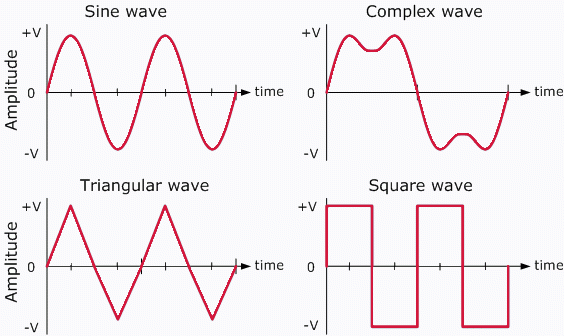AC Waveforms
Circuits – AC Waveforms
An alternating function or AC Waveform on the other hand is defined as one that varies in both magnitude and direction in more or less an even manner with respect to time making it a “Bi-directional” waveform. An AC function can represent either a power source or a signal source with the shape of an AC waveform generally following that of a mathematical sinusoid being defined as: A(t) = Amax*sin(2πƒt).
The term AC or to give it its full description of Alternating Current, generally refers to a time-varying waveform with the most common of all being called a Sinusoid better known as a Sinusoidal Waveform. Sinusoidal waveforms are more generally called by their short description as Sine Waves. Sine waves are by far one of the most important types of AC waveform used in electrical engineering.
The shape obtained by plotting the instantaneous ordinate values of either voltage or current against time is called an AC Waveform. An AC waveform is constantly changing its polarity every half cycle alternating between a positive maximum value and a negative maximum value respectively with regards to time with a common example of this being the domestic mains voltage supply we use in our homes.
This means then that the AC Waveform is a “time-dependent signal” with the most common type of time-dependant signal being that of the Periodic Waveform. The periodic or AC waveform is the resulting product of a rotating electrical generator. Generally, the shape of any periodic waveform can be generated using a fundamental frequency and superimposing it with harmonic signals of varying frequencies and amplitudes but that’s for another tutorial.
Alternating voltages and currents can not be stored in batteries or cells like direct current (DC) can, it is much easier and cheaper to generate these quantities using alternators or waveform generators when they are needed. The type and shape of an AC waveform depends upon the generator or device producing them, but all AC waveforms consist of a zero voltage line that divides the waveform into two symmetrical halves. The main characteristics of an AC Waveform are defined as:
AC Waveform Characteristics
- The Period, (T) is the length of time in seconds that the waveform takes to repeat itself from start to finish. This can also be called the Periodic Time of the waveform for sine waves, or the Pulse Width for square waves.
- The Frequency, (ƒ) is the number of times the waveform repeats itself within a one second time period. Frequency is the reciprocal of the time period, ( ƒ = 1/T ) with the unit of frequency being the Hertz, (Hz).
- The Amplitude (A) is the magnitude or intensity of the signal waveform measured in volts or amps.
In our tutorial about Waveforms ,we looked at different types of waveforms and said that “Waveforms are basically a visual representation of the variation of a voltage or current plotted to a base of time”. Generally, for AC waveforms this horizontal base line represents a zero condition of either voltage or current. Any part of an AC type waveform which lies above the horizontal zero axis represents a voltage or current flowing in one direction.
Likewise, any part of the waveform which lies below the horizontal zero axis represents a voltage or current flowing in the opposite direction to the first. Generally for sinusoidal AC waveforms the shape of the waveform above the zero axis is the same as the shape below it. However, for most non-power AC signals including audio waveforms this is not always the case.
The most common periodic signal waveforms that are used in Electrical and Electronic Engineering are the Sinusoidal Waveforms. However, an alternating AC waveform may not always take the shape of a smooth shape based around the trigonometric sine or cosine function. AC waveforms can also take the shape of either Complex Waves, Square Waves or Triangular Waves and these are shown below.

The time taken for an AC Waveform to complete one full pattern from its positive half to its negative half and back to its zero baseline again is called a Cycle and one complete cycle contains both a positive half-cycle and a negative half-cycle. The time taken by the waveform to complete one full cycle is called the Periodic Time of the waveform, and is given the symbol “T”.
The number of complete cycles that are produced within one second (cycles/second) is called the Frequency, symbol ƒ of the alternating waveform. Frequency is measured in Hertz, ( Hz ) named after the German physicist Heinrich Hertz.
Then we can see that a relationship exists between cycles (oscillations), periodic time and frequency (cycles per second), so if there are ƒ number of cycles in one second, each individual cycle must take 1/ƒ seconds to complete.
Read article – Alternating Current
Visit NCERTplanet.com for NCERT solutions and Textbook downloads



